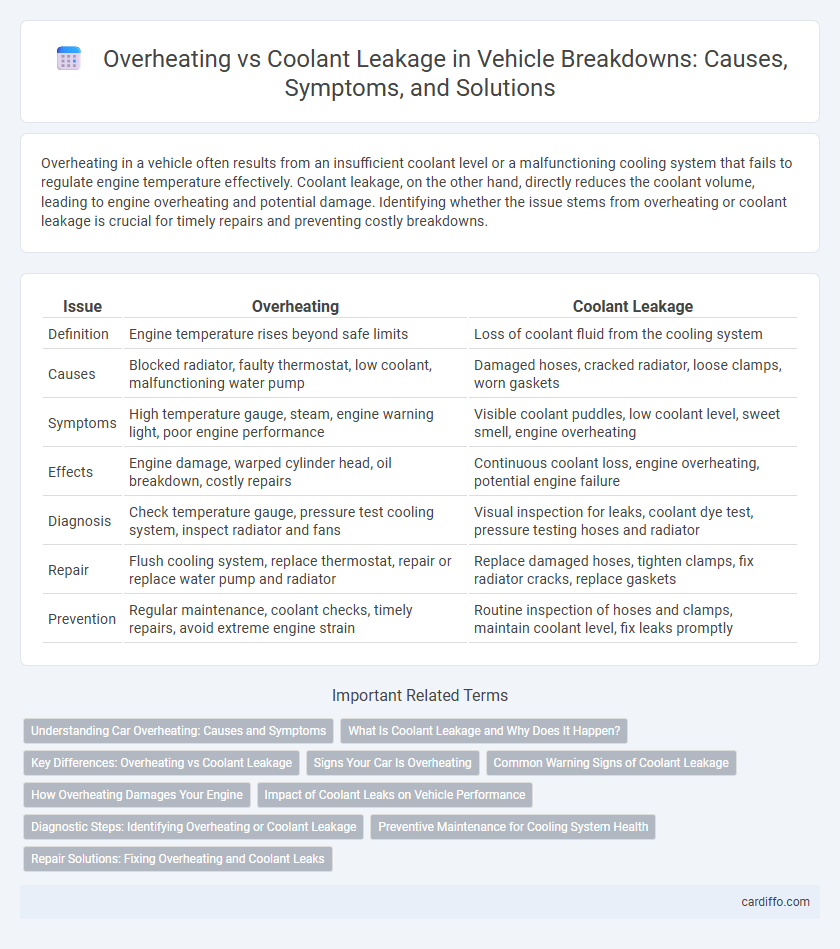Overheating in a vehicle often results from an insufficient coolant level or a malfunctioning cooling system that fails to regulate engine temperature effectively. Coolant leakage, on the other hand, directly reduces the coolant volume, leading to engine overheating and potential damage. Identifying whether the issue stems from overheating or coolant leakage is crucial for timely repairs and preventing costly breakdowns.
Table of Comparison
| Issue | Overheating | Coolant Leakage |
|---|---|---|
| Definition | Engine temperature rises beyond safe limits | Loss of coolant fluid from the cooling system |
| Causes | Blocked radiator, faulty thermostat, low coolant, malfunctioning water pump | Damaged hoses, cracked radiator, loose clamps, worn gaskets |
| Symptoms | High temperature gauge, steam, engine warning light, poor engine performance | Visible coolant puddles, low coolant level, sweet smell, engine overheating |
| Effects | Engine damage, warped cylinder head, oil breakdown, costly repairs | Continuous coolant loss, engine overheating, potential engine failure |
| Diagnosis | Check temperature gauge, pressure test cooling system, inspect radiator and fans | Visual inspection for leaks, coolant dye test, pressure testing hoses and radiator |
| Repair | Flush cooling system, replace thermostat, repair or replace water pump and radiator | Replace damaged hoses, tighten clamps, fix radiator cracks, replace gaskets |
| Prevention | Regular maintenance, coolant checks, timely repairs, avoid extreme engine strain | Routine inspection of hoses and clamps, maintain coolant level, fix leaks promptly |
Understanding Car Overheating: Causes and Symptoms
Car overheating occurs when the engine temperature exceeds safe limits, often due to coolant leakage, blocked radiators, or a malfunctioning thermostat. Symptoms include a rising temperature gauge, steam from the engine, and unusual smells, signaling urgent attention to avoid severe engine damage. Identifying coolant leaks early and maintaining proper coolant levels are crucial to preventing overheating and ensuring engine longevity.
What Is Coolant Leakage and Why Does It Happen?
Coolant leakage occurs when the engine's cooling system loses its liquid coolant due to cracks, damaged hoses, or failing seals, leading to insufficient heat dissipation. This leakage reduces the coolant level, causing the engine to overheat as it cannot regulate temperature effectively. Key causes include worn-out gaskets, radiator damage, and corrosion within the cooling system.
Key Differences: Overheating vs Coolant Leakage
Overheating occurs when the engine temperature rises excessively due to insufficient cooling, while coolant leakage involves the loss of coolant fluid from the system. Overheating typically results from a malfunctioning radiator, thermostat, or water pump, whereas coolant leakage is commonly caused by damaged hoses, radiator cracks, or a faulty gasket. Proper diagnosis differentiates overheating caused by internal failures from coolant leakage leading to temperature imbalances.
Signs Your Car Is Overheating
Visible steam rising from under the hood signals your car is overheating, often accompanied by a rapidly rising temperature gauge. A sweet smell inside or outside the car can indicate coolant leakage, but overheating signs include engine misfires, a boiling radiator, or sudden loss of power. Check for warning lights on the dashboard that specifically indicate overheating or low coolant levels for early detection.
Common Warning Signs of Coolant Leakage
Common warning signs of coolant leakage include visible puddles of bright green, orange, or pink fluid under the vehicle, a persistent sweet smell near the engine, and an unexplained drop in coolant levels on the reservoir gauge. Engine overheating accompanied by steam from the radiator or heater core also indicates a potential coolant leak. Monitoring temperature gauges and inspecting hoses regularly can prevent severe engine damage caused by coolant loss.
How Overheating Damages Your Engine
Overheating causes significant engine damage by warping cylinder heads, damaging the head gasket, and leading to cracked engine blocks. Coolant leakage reduces the cooling system's efficiency, causing the engine temperature to rise rapidly and exacerbating overheating issues. Persistent overheating results in costly repairs due to distorted engine components and potential complete engine failure.
Impact of Coolant Leaks on Vehicle Performance
Coolant leaks significantly reduce the coolant level, causing engine temperatures to rise and increasing the risk of overheating. Persistent overheating can lead to severe damage such as warped cylinder heads and blown head gaskets. Maintaining a proper coolant level ensures optimal engine performance and prevents costly repairs.
Diagnostic Steps: Identifying Overheating or Coolant Leakage
Diagnosing overheating or coolant leakage involves first checking the engine temperature gauge and inspecting for visible coolant puddles or wet spots under the vehicle. Next, examine the radiator, hoses, and coolant reservoir for cracks, clogs, or loose connections that may cause fluid loss or insufficient cooling. Conduct a pressure test on the cooling system to detect hidden leaks and monitor coolant levels consistently to distinguish between overheating due to coolant loss or mechanical failure.
Preventive Maintenance for Cooling System Health
Regular inspection of the cooling system, including radiator, hoses, and coolant levels, is crucial to prevent overheating and coolant leakage. Using manufacturer-recommended coolant and flushing the system periodically helps maintain optimal thermal regulation and prevents corrosion or blockages. Ensuring the thermostat and water pump function properly extends engine life and reduces the risk of costly breakdowns caused by cooling system failure.
Repair Solutions: Fixing Overheating and Coolant Leaks
Repair solutions for overheating and coolant leaks center on identifying the root cause, such as a faulty radiator, cracked hoses, or a damaged water pump. Replacing worn or damaged components and flushing the cooling system restores optimal coolant flow and heat dissipation. Proper maintenance and prompt repairs prevent engine damage and maintain reliable vehicle performance.
Overheating vs coolant leakage Infographic

 cardiffo.com
cardiffo.com